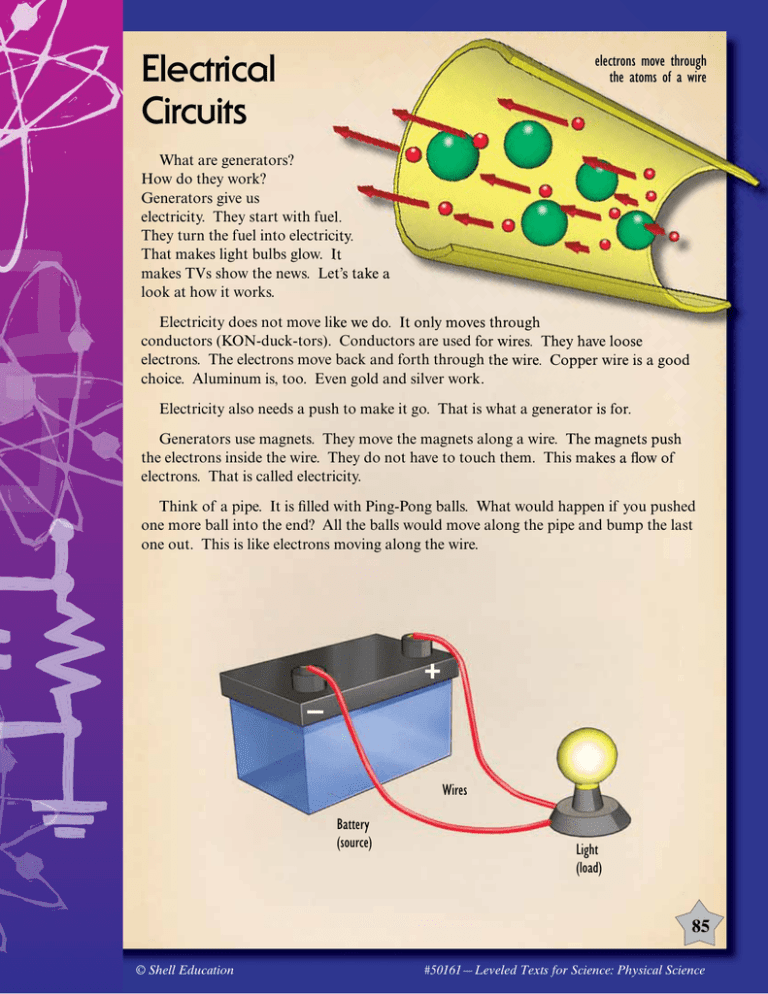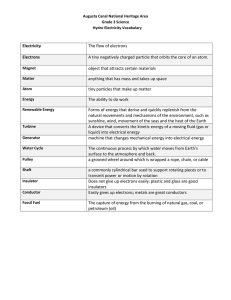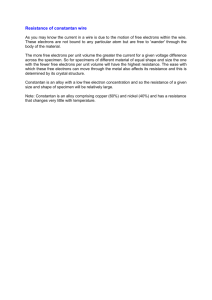Physical Science Leveled Text Electrical Circuits
advertisement

electrons move through the atoms of a wire Electrical Circuits What are generators? How do they work? Generators give us electricity. They start with fuel. They turn the fuel into electricity. That makes light bulbs glow. It makes TVs show the news. Let’s take a look at how it works. Electricity does not move like we do. It only moves through conductors (KON-duck-tors). Conductors are used for wires. They have loose electrons. The electrons move back and forth through the wire. Copper wire is a good choice. Aluminum is, too. Even gold and silver work. Electricity also needs a push to make it go. That is what a generator is for. Generators use magnets. They move the magnets along a wire. The magnets push the electrons inside the wire. They do not have to touch them. This makes a flow of electrons. That is called electricity. Think of a pipe. It is filled with Ping-Pong balls. What would happen if you pushed one more ball into the end? All the balls would move along the pipe and bump the last one out. This is like electrons moving along the wire. + – Wires Battery (source) Light (load) 85 © Shell Education #50161—Leveled Texts for Science: Physical Science Amps and Volts The generator’s magnet pushes. The electrons go down the wire. We can measure this two ways. The magnet pushes a number of electrons. That is measured in amperes (AM-peers). It is called amps for short. The magnet also puts a force on the electrons. This is measured in volts. Amps and volts are put together to see how much power is used. This is called watts. Watts are amps times volts. That tells you two things. It tells you how many electrons are moving. It also tells you how much force is behind them. AC vs. DC Thomas Edison made the first light bulb. He wanted to sell electricity. He wanted to bring it into homes. He made a promise to light up New York. There was one problem. The electricity for homes was direct current. That is called DC for short. The electrons always went the same way down the wire. DC cannot go very far. The electrons fall out of the wire. DC is not good for homes. Nikola Tesla worked for Edison. He had an idea. He wanted to move the electrons a new way. He made electrons go back and forth very fast. They changed direction many times in one second. He called it alternating current. It is called AC for short. This let electricity go much farther. The two men both wanted their way. Edison wanted DC. Tesla wanted AC. In the end, Tesla’s ideas worked best. Today, we use AC in our homes. Electrons travel along this wire to the bulb. generator Comprehension Question How is electricity like balls in a pipe? 86 #50161—Leveled Texts for Science: Physical Science © Shell Education electrons move through the atoms of a wire Electrical Circuits What is a generator? How does it work? Generators give us electricity. They start with fuel from other things. This is turned into electricity. Electricity is what makes a light bulb glow. It makes a television show the news. Let’s take a look at how it works. First, electricity does not move like we do. It only moves through conductors (KON-duck-tors). Conductors are used for wires. They have loose electrons. The electrons move back and forth through the wire. Copper wire is a good choice. Aluminum is, too. Even gold and silver can be used. Electricity also needs a push to make it go. That is what a generator is for. Generators use magnets. They move the magnets along a wire. The magnets push the electrons inside the wire. They do not have to touch them. This creates a flow of electrons. That is electricity. Imagine a pipe. It is filled with Ping-Pong balls. What would happen if you pushed one more ball into the end? All the balls would move along the pipe and bump the last one out. This is like electrons moving along the wire. + – Wires Battery (source) Light (load) 87 © Shell Education #50161—Leveled Texts for Science: Physical Science Amps and Volts The generator’s magnet pushes. The electrons go down the wire. We can measure this two ways. The magnet pushes a number of electrons. That is measured in amperes (AM-peers). It is called amps for short. The magnet also puts pressure on the electrons. This is measured in volts. Amps and volts are put together to see how much power is used. This is measured in watts. Watts are amps times volts. Watts tell you how many electrons are moving and how much force is behind them. AC vs. DC Thomas Edison invented the light bulb. He wanted to sell electricity. He wanted to bring it into people’s homes. He also made a promise. He said he would light up New York. There was a problem, though. The electricity for homes was direct current. That is called DC for short. The electrons always went in the same way down the wire. DC cannot travel long distances. The electrons fall out of the wire. DC is not good for homes. Nikola Tesla worked for Thomas Edison. He had an idea. He wanted to use another kind of current. Alternating current makes electrons go back and forth very fast. They change direction many times in one second. Alternating current is called AC for short. This makes it easy for electricity to travel over long distances. The two men both thought they had the best idea. Edison wanted DC. Tesla wanted AC. In the end, Tesla’s ideas worked best. Today, we use AC in our homes. Electrons travel along this wire to the bulb. Comprehension Question generator Describe an electrical current. 88 #50161—Leveled Texts for Science: Physical Science © Shell Education electrons move through the atoms of a wire Electrical Circuits What is a generator? How does it work? Generators give us electrical energy. It starts with energy from other things. It turns that into electricity. This energy is what makes a light bulb glow. It makes a television show the news. Let’s take a look at how it works. First, electricity moves through conductors (KON-duck-tors). Conductors are materials that share electrons easily. The electrons move between the atoms. Copper wire is a good choice. Aluminum, gold, and silver are other metals that can also be used. Electricity also needs a push to get it moving. That is what a generator is for. Generators move the magnets along a wire. The magnets push the electrons inside the wire. They do not have to touch them. This creates a flow of electrons. That is electricity. Imagine a pipe. This is like the wire. It is filled with Ping-Pong balls. What would happen if you pushed one more ball into the end? All the balls would move along the pipe and bump the last one out. This is like electrons moving along the wire. + – Wires Battery (source) Light (load) 89 © Shell Education #50161—Leveled Texts for Science: Physical Science Amps and Volts The generator’s magnet pushes the electrons down the wire. Two things happen. The magnet pushes a certain number of electrons along the wire. This is measured in amperes (AM-peers). They are also called amps for short. The magnet also puts pressure on the electrons. This is measured in volts. Amps and volts are put together to see how much power is being used. This is measured in watts. Watts are found by multiplying the amps and volts together. That tells you how many electrons are moving and how much force is behind all those electrons. AC vs. DC Thomas Edison invented the light bulb in 1879. He wanted to sell electricity. He wanted to bring it into people’s homes. He promised to light up New York. There was a problem, though. The electricity for homes was direct current, or DC for short. The electrons always went in the same direction down the wire. DC cannot travel long distances. The electrons fall out of the wire. DC is not good for homes. Nikola Tesla worked for Thomas Edison. He had an idea. He wanted to use another kind of current. Alternating current, or AC, makes electrons go back and forth very fast. They change direction many times in one second. This makes it easy for electricity to travel over long distances. The two men argued. Edison wanted DC. Tesla wanted AC. In the end, Tesla’s ideas worked best. Today, we use AC in our homes. Electrons travel along this wire to the bulb. Comprehension Question generator How are AC and DC different? 90 #50161—Leveled Texts for Science: Physical Science © Shell Education Electrical Circuits electrons move through the atoms of a wire What exactly is a generator, and how does it work? An electrical generator converts energy from other sources into electrical energy. This energy is what makes a light or a television work when switched on. To better understand how these forces work, let’s take a look at how an electrical current and electromagnetism are made. First, electricity needs a conductor to move it from one point to another. Materials that are good conductors have electrons that move easily. Copper wire is a good conductor. Aluminum, gold, and silver are other metals that are sometimes used as conductors. Electricity also needs something to get it moving through the conductor. Generators are often used to do this. Generators use magnets to push the electricity along a wire. The magnets push the electrons inside the wire without having to touch them. This creates a steady flow of electricity. Imagine a pipe. This represents the wire. It is filled with Ping-Pong balls. What would happen if you pushed one more ball into the end? All the balls would move along the pipe and bump the last one out. This is like electrons moving along the wire and into an electrical appliance. + – Wires Battery (source) Light (load) 91 © Shell Education #50161—Leveled Texts for Science: Physical Science Amps and Volts As a generator’s magnet pushes the electricity along the wire, two things happen. The magnet pushes a specific number of electrons along the wire. This electrical current is measured in amperes (AM-peers), or amps. The magnet is also putting pressure on the electrons. This pressure is measured in volts. Amps and volts are put together to determine how much power is being used. This is measured in watts. Watts are found by multiplying the amps and volts together. That tells you how many electrons are moving and how much force is behind all those electrons. AC vs DC After Thomas Edison invented the light bulb in 1879, he worked to bring electricity into people’s homes. He also made a promise. He wanted to light up the city of New York. There was a problem, though. The electricity for homes was direct current, or DC. This is a current pushed through a circuit and flowing continuously in the same direction. Low-voltage DC currents cannot travel long distances because there are such high losses in the cables that carry them. That means DC is not good for powering our homes. Nikola Tesla, who worked for Thomas Edison, had an idea. He wanted to use another kind of electric current. Alternating current, or AC, changes direction back and forth many times in one second. This makes it easy for electricity to travel over long distances. The two men didn’t agree. In the end, Tesla’s ideas worked best. Today, the electricity that comes from a power plant and is used in our homes is AC. Electrons travel along this wire to the bulb. Comprehension Question Compare and contrast alternating and direct currents. generator 92 #50161—Leveled Texts for Science: Physical Science © Shell Education



